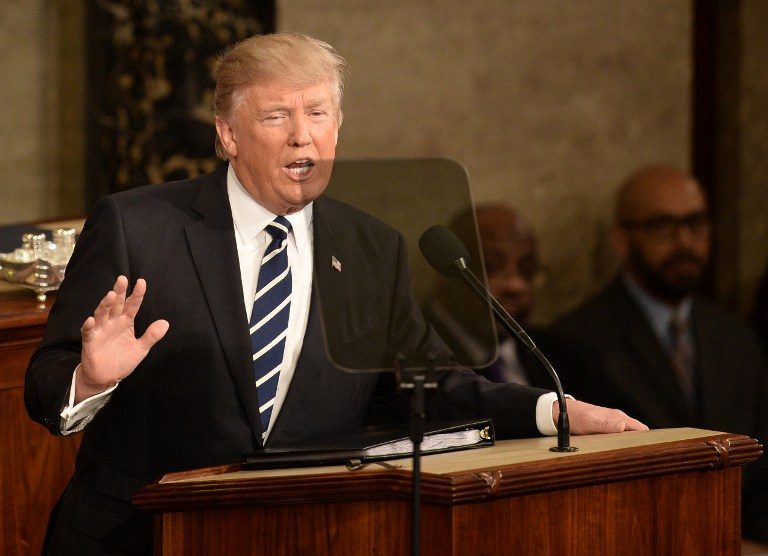SUMMARY
This is AI generated summarization, which may have errors. For context, always refer to the full article.

WASHINGTON DC – US President Donald Trump outlined an ambitious agenda for his government Tuesday, February 28 (Wednesday, March 1 in Manila), during an address to a joint session of the US Congress.
He came to Capitol Hill hailing a “new national pride” and daring lawmakers to rally behind his plans to dramatically slash government spending, industrial regulation and tax, curb immigration, and overhaul health care.
Here are the main points of his hour-long primetime address.
Immigration
Trump touted tougher immigration enforcement as the keystone of a drive to boost American employment and wages, and slash crime.
While pushing for tougher law enforcement, he also vowed to introduce a new merit-based system to regulate new arrivals in the United States and reduce the flow of unskilled workers, as he held out the prospect of a sweeping immigration reform.
He said it will “save countless dollars, raise workers’ wages, and help struggling families – including immigrant families – enter the middle class.”
“It is a basic principle that those seeking to enter a country ought to be able to support themselves financially,” he told lawmakers.
Economy and trade
Trump also touched on the economy, saying that “restarting” the American economy will be the key to accomplishing the country’s goals.
At the center is tax reform. Trump wants to reduce tax rates for companies, and provide a “massive tax relief” for the middle class, without laying out specifics.
He also said that he will aim for “fair trade,” lamenting what he calls unfair trade practices of other countries.
He added that American products are slapped with high tariffs abroad, but foreign companies are “charged almost nothing” when shipping to America.
“I am not going to let America and its great companies and workers, be taken advantage of anymore,” he said.
Infrastructure
Trump pledged to bring $1 trillion in public and private investment to rebuild what he called America’s crumbling infrastructure.
This is a move to make good on one of his main campaign pledges – rebuilding America’s roads, bridges, airports, and other public structures.
“To launch our national rebuilding, I will be asking the Congress to approve legislation that produces a $1-trillion investment in the infrastructure of the United States – financed through both public and private capital – creating millions of new jobs,” Trump said.
He gave no details on how the money would be spent.
Defense, diplomacy, security
Trump insisted on his support for the NATO alliance, but again insisted that members must pay their way and warned it is not his job to “represent the world.”
“We strongly support NATO,” he said. “But our partners must meet their financial obligations.
“We expect our partners, whether in NATO, in the Middle East or the Pacific to take a direct and meaningful role in both strategic and military operations, and pay their fair share of the cost.”
“And now, based on our very strong and frank discussions, they are beginning to do just that.”
“In fact, I can tell you the money is pouring in,” Trump added, in a departure from his prepared remarks.
“My job is not to represent the world. My job is to represent the United States of America,” he said.
He also mentioned his plan to “rebuild” the US military, with a budget that calls for one of the largest increases in national defense spending and veterans.
“To keep America safe we must provide the men and women of the United States military with the tools they need to prevent war and – if they must – to fight, and they only have to win,” he said.
Healthcare
As expected, Trump told the lawmakers to find a way to “repeal and replace” the Affordable Care Act, better known as Obamacare.
He said mandating Americans to buy government-approved healthcare was “never the right solution for America.”
“The way to make health insurance available to everyone is to lower the cost of health insurance, and that is what we will do,” he added.
Trump outlined 5 guiding principles for the repeal and replacement of Obamacare:
- “Stable transition” for those currently insured in the healthcare exchanges, and to make sure those with pre-existing conditions have access
- Help citizens purchase own coverage through tax credits and expanded Health Savings Accounts
- Grant state governors “resources and flexibility” with Medicaid
- Work on ensuring patients and doctors don’t incur “unnecessary costs that drive up the price of insurance” and bring down drug prices
- Allow citizens to buy health insurance in other states
School choice
Citing education as “the civil rights issue of our time,” Trump called on Congress to pass an education bill that will fund school choice, which will give students options outside the public school system.
“I am calling upon members of both parties to pass an education bill that funds school choice for disadvantaged youth, including millions of African-American and Latino children,” he said. “These families should be free to choose the public, private, charter, magnet, religious or home school that is right for them.”
– with reports from KD Suarez and Agence France-Presse / Rappler.com
Add a comment
How does this make you feel?
There are no comments yet. Add your comment to start the conversation.